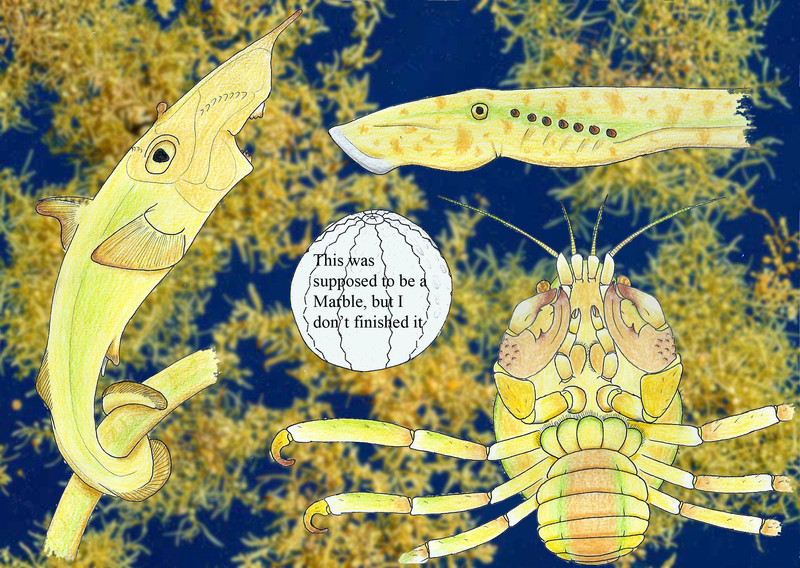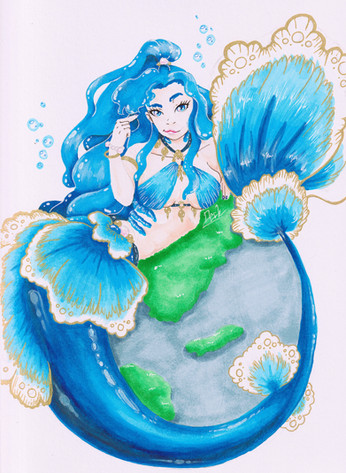HOME | DD
 AngryCyan — Floating Forests
AngryCyan — Floating Forests

#kelp #kelpforest #speculativeevolution #speculativebiology #speculativezoology #specevo #specevolution #speculative_evolution #speculative_biology
Published: 2020-04-01 08:41:25 +0000 UTC; Views: 2089; Favourites: 27; Downloads: 0
Redirect to original
Description
Our journey through Emesh is taking an hiatus, at least for the moment, and now we are heading to Atlacoya, the central continent and the driest of all, as it contains the largest desert of the entire planet inside. But along the way, we will visit two of the most abundant marine biomes in the Northern Hemisphere during the Early Fitoglacenian.The first of these will be the Floating Forest, a variant of the Kelp Forest or the Urchin Forest that is characterized by, as the name suggests, floating on the high seas. These tangles of derived Kelp act as small oases of life in the immense desert that is the open sea, where food is scarce or in the form of microscopic organisms that only the most specialized can use in abundance. But why is the Floating Forest so distributed by the Arctic Sea and on top of the Anuket Sea? This is due the geography of Tletonatiuh, being a planet with large tracts of land, most of the seas are closed by the continents, which forces currents to form loops that keep biodiversity trapped in them. This prevents the Floating Forest from spreading over other seas, but also keeps it safe from ending up in dangerous or deadly zones for the Floating Kelp, as well as moving individual forests through nutrient-rich areas and warmer areas as they move by the loop, so this effect ends up being beneficial for the Kelp.
But the seaweed that forms the forest is not like the Kelp we know on earth, it has had to adapt to survive the open sea, and some of its adaptations are reminiscent of the Sargassum of the earth. The Floating Kelp is derived from branches of the seaweed that were cut by Urchins and managed to make their way in the open ocean, achieving reproduction, and for millions of years natural selection has molded their bodies reaching the algae that now thrives in this environment. Instead of growing linearly upwards, the floating Kelp grows radially, with secondary branches sprouting from the main ones and forming a strange tangle of yellowish branches. The bags of gas appear randomly by the branches, and they have a tiny leaf at the end, in a vestigial manner. Conversely, the functional leaves have almost completely lost the gas bag and are now smaller and thicker. But their adaptations do not end there, the open sea in a nutrient-poor environment, and this is the reason why floating forests are scarce in the evolutionary record, but the Floating Kelp has found a solution to this. When the branches reach a certain depth and stop receiving so much light, the leaves that grow begin to have a fluffy and filamentous appearance, and gas pockets are no longer produced. As the branch continues to fall, its own appearance changes and branches grow abundant filaments and short branches filled with tiny hairs. These structures act like the roots of true plants, absorbing nutrients from the water, but avoid filling with salt thanks to abundant sodium pumps present in these structures and in the functional leaves. This indicates that the Floating Kelp has developed a functional fluid conductor system, becoming one of the most complex algae that have evolved and gradually approaching the level of true plants. In addition to this, floating Kelp produces large amounts of spores, but these remain attached to the mother plant, and have massive zygotes that disperse the species and form new forests.
In the Floating Kelp they inhabit a great amount of creatures, most of them of small size, that feed of the own Kelp or their tenants, but the most remarkable of them are the Marbles. These small Urchins have managed to reach these forests and thrive, being one of the smallest echinoderms that have ever evolved, since they have on average radius of 4mm, but this drastic reduction in size has cost them a price, and the lantern Aristotle which helps other Urchins to chew has been very simplified to fit into the smaller body, and even then it occupies almost 35% of its volume. Its body is spherical and curiously devoid of thorns, this is cause they were not useful to the small Marbles, and even made it difficult to move through the Floating Forest by not allowing the tube feet to reach a certain branch, or impeding traverse a gap between two branches. So as they adapted to this new environment, the ancestors of the Marbles lost the spines, but also lengthened their tube feet, and now they have become tentacle-like appendages that help them move through the Kelp. Sometimes the branches protrude from the water, something terribly difficult for other Urchins to reach, since without the surrounding water their hydraulic system would lose all its contents and become useless, something even more dangerous for the Marbles, who depend completely on it for your locomotion. Unexpectedly, it is common to see these little Urchins feed on the leaves that come to the surface, How is that possible? The answer lies in its madreporite, because underneath it has formed a structure similar to a valve, which allows the water to let in, but not to leave, so the walks through the leaves exposed to the air are not really dangerous for the pioneer Marbles.
In addition to echinoderms, the Floating Forests are always surrounded by a cloud of small crustaceans, descendants of the benthic Astacidae that have reduced their size and now swim in the water column, feeding on the tiny algae present in it. Many of them remind us of the small Shrimp of the Earth, and really there are not many differences between these two groups, so we will not go deep into them, but in their role in these ecosystems. The New Shrimps are really abundant, forming banks around the Floating Kelp, and are a source of food for many other creatures that inhabit these oases of marine life. The first to be mentioned are the Springtails, small descendants of the Chimeras that have adapted as ambush hunters in these forests, clinging to the Floating Kelp with a prehensile tail that twine around the branches, and that gives them the name. To surprise the small Shrimp, the Springtails have adapted their bodies to resemble the surrounding leaves, and although their mimicry is not particularly good and is largely based on mimicking the golden color of the Kelp, it is enough for crustaceans to not notice their presence. Then, when a New Shrimp is close enough, the Springtail will give a strong blow with its pectoral fins and close its jaws on the unsuspecting crustacean, which will serve as food for the little chimera for at least a few days.
Other predators follow the model of ambush hunter, such as the Mouthbag, close relatives of the Lampilchard. Both groups descend from Lamprey who had to look for new sources of food, and thanks to an extended larval stage, during their first years of their life they are filtration feeders that roam the small seas of Tletonatiuh. The main difference between both groups is their adult stage, and while the adult Lampilchards are not very different from their ancestors, the Mouthbags have specialized in living in the Floating Forests, and like the Sprintails, they have developed a certain mimicry. Its golden color, broken by spots of a darker mustard color, allows it to fade between the branches of the Kelp, and its caudal and dorsal fins have been modified to look like a continuous line of small leaves. Even so, the biggest change is in his mouth, since thousands of years feeding on creatures with exoskeleton has favored a new morphology. Their lips have lengthened and form a sack (which gives them their name) covered by thick flattened and rounded denticles designed to crush their prey. When a New Shrimp, again, gets close enough, the Mouthbag will pump water through its gills generating a suction effect that will carry its small prey directly to the mouth sac, where it will be crushed by the denticles.
Already finishing our visit, not all the inhabitants of the Floating Forest are sessile creatures that live attached to the Kelp, swimming among its branches there are dozen species of small Fishtails that seek refuge in the marine desert. We will also talk about the Fishtails when we visit the Reefs, but in this first sighting we can talk about their ancestry, being a group of Chimeras that has readapted to active swimming using their tails, which is now bilobed and reminiscent of their distant relatives, the Sharks. In the rest of their anatomy they are still very similar to their ancestors, but their diets have varied considerably, being a generalist group with herbivorous and carnivorous representatives alike. Other inhabitants of the branches of the Kelp are several crustacean species similar to crabs and lobsters that inhabit the seabed, which reached these forests when they were small larvae that floated in the plankton. The vast majority of these species of crustaceans are herbivores that feed on the nutritious stems and leaves of the floating Kelp, and thanks to natural selection some of them have lengthened their legs to facilitate movement through this plant tangle, being able to grab the distant branches without fearing the abyss below, plagued by ferocious predators. These better adapted crabs are called Swing-Crabs, due to the rocking movement they make moving from branch to branch. Its body is strongly protected by large claws, which are resting against the chest of the Crab, so the predatory Fishtails usually attack the legs, and it is not strange to see a Swing-Crab without several legs. These are regenerated in a few molts as in most crustaceans, so they are not a major problem.






















